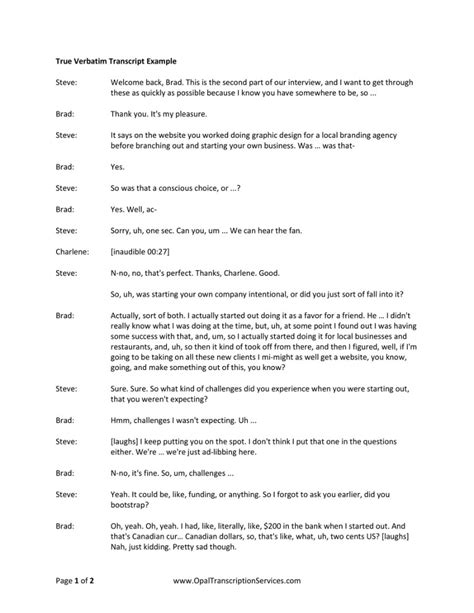Complete Guide: Writing Interview Transcripts Effectively In English

Welcome to our complete guide on how to write interview transcripts effectively in English. Whether you are a journalist, researcher, or simply conducting an interview for personal reasons, it is essential to accurately transcribe the conversation. In this guide, we will provide you with step-by-step instructions and tips to ensure that your interview transcripts are comprehensive and well-written.
1. Prepare Before the Interview
Before conducting the interview, it is crucial to make adequate preparations. Follow these steps to ensure a smooth transcription process:
- Research the interviewee: Familiarize yourself with the background, expertise, and previous work of the person you will be interviewing.
- Create a list of questions: Develop a comprehensive list of questions that cover the topics you wish to explore during the interview.
- Check recording equipment: Test your recording equipment to ensure that it is functioning properly and has enough storage capacity.
2. During the Interview
During the interview, it is essential to maintain a professional and organized approach to ensure accurate transcription. Consider the following tips:
- Speak clearly: Enunciate your words clearly and ask the interviewee to do the same.
- Take detailed notes: While recording the conversation, also take notes of key points, quotes, and important information.
- Clarify unclear statements: If the interviewee’s response is unclear, politely ask for clarification to avoid any confusion later.
3. Transcribing the Interview
After the interview, it’s time to transcribe the conversation. Follow these steps to ensure an efficient and accurate transcription process:
- Listen to the recording: Begin by listening to the recording carefully, focusing on capturing every word and nuance.
- Use transcription software: Consider using transcription software to facilitate the process, as it can help with playback speed control and automatic timestamping.
- Segment the transcript: Break the conversation into smaller segments or paragraphs to make it easier to read and understand.
- Format the transcript: Use proper formatting techniques, such as indentation for speaker attribution and paragraph breaks for each speaker’s turn.
4. Proofreading and Editing
Once you have completed the initial transcript, it is crucial to proofread and edit it for accuracy and clarity. Follow these steps:
- Check for errors: Carefully review the transcript for any errors, such as spelling mistakes, grammatical errors, or missing words.
- Ensure coherence: Make sure the transcript flows smoothly and is coherent, with proper organization of ideas and logical sequencing.
- Remove unnecessary filler words: Remove any unnecessary filler words or speech disfluencies to improve readability.
5. Finalizing the Transcript
Before considering the transcript complete, follow these final steps to ensure its accuracy and professionalism:
- Verify names and terminology: Double-check the spelling of names, technical terms, and any other specialized vocabulary used during the interview.
- Add timestamps (if necessary): If required, add timestamps at regular intervals to facilitate referencing specific parts of the conversation.
- Proofread once more: Give the transcript a final proofread to catch any remaining errors or inconsistencies.
Conclusion
Writing interview transcripts effectively requires careful planning, active listening, and meticulous editing. By following the steps outlined in this guide, you can ensure that your interview transcripts are accurate, comprehensive, and professional. Remember, a well-written transcript is essential for preserving the integrity of the interview and effectively communicating its content.
Frequently Asked Questions
1. Why is it important to transcribe interview recordings?
Transcribing interview recordings allows for a detailed and accurate record of the conversation. It helps in analyzing the content, referencing specific information, and verifying quotes or statements.
2. Can I use transcription software for interview transcripts?
Yes, transcription software can be a valuable tool for transcribing interview recordings. It can help in speeding up the process and ensure accurate timestamps.
3. Should I include filler words in the transcript?
It is generally recommended to remove unnecessary filler words to improve readability and clarity. However, it depends on the context and purpose of the interview transcript.
4. How can I ensure the accuracy of the transcript?
To ensure accuracy, it is essential to carefully listen to the recording, cross-check names and terminology, and proofread the transcript multiple times. It may also be helpful to have a second person review the transcript for any errors or inconsistencies.
5. Are there any specific formatting guidelines for interview transcripts?
While there are no strict formatting guidelines, it is important to maintain consistency throughout the transcript. Use indentation for speaker attribution and consider breaking the conversation into paragraphs for each speaker’s turn.
